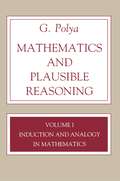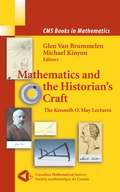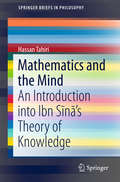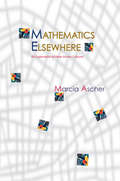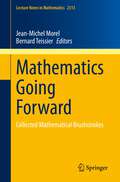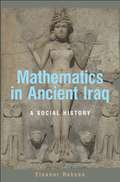- Table View
- List View
Mathematics and Philosophy 2: Graphs, Orders, Infinites and Philosophy
by Daniel ParrochiaFrom Pythagoreans to Hegel, and beyond, this book gives a brief overview of the history of the notion of graphs and introduces the main concepts of graph theory in order to apply them to philosophy. In addition, this book presents how philosophers can use various mathematical notions of order. Throughout the book, philosophical operations and concepts are defined through examining questions relating the two kinds of known infinities – discrete and continuous – and how Woodin's approach can influence elements of philosophy. We also examine how mathematics can help a philosopher to discover the elements of stability which will help to build an image of the world, even if various approaches (for example, negative theology) generally cannot be valid. Finally, we briefly consider the possibilities of weakening formal thought represented by fuzziness and neutrosophic graphs. In a nutshell, this book expresses the importance of graphs when representing ideas and communicating them clearly with others.
Mathematics and Plausible Reasoning, Volume 1: Induction and Analogy in Mathematics
by G. PolyaA guide to the practical art of plausible reasoning, this book has relevance in every field of intellectual activity. Professor Polya, a world-famous mathematician from Stanford University, uses mathematics to show how hunches and guesses play an important part in even the most rigorously deductive science. He explains how solutions to problems can be guessed at; good guessing is often more important than rigorous deduction in finding correct solutions. Vol. I, on Induction and Analogy in Mathematics, covers a wide variety of mathematical problems, revealing the trains of thought that lead to solutions, pointing out false bypaths, discussing techniques of searching for proofs. Problems and examples challenge curiosity, judgment, and power of invention.
Mathematics and Plausible Reasoning, Volume 1: Induction and Analogy in Mathematics
by G. PolyaA guide to the practical art of plausible reasoning, this book has relevance in every field of intellectual activity. Professor Polya, a world-famous mathematician from Stanford University, uses mathematics to show how hunches and guesses play an important part in even the most rigorously deductive science. He explains how solutions to problems can be guessed at; good guessing is often more important than rigorous deduction in finding correct solutions. Vol. I, on Induction and Analogy in Mathematics, covers a wide variety of mathematical problems, revealing the trains of thought that lead to solutions, pointing out false bypaths, discussing techniques of searching for proofs. Problems and examples challenge curiosity, judgment, and power of invention.
Mathematics and Plausible Reasoning, Volume 2: Logic, Symbolic and mathematical
by G. PolyaA guide to the practical art of plausible reasoning, this book has relevance in every field of intellectual activity. Professor Polya, a world-famous mathematician from Stanford University, uses mathematics to show how hunches and guesses play an important part in even the most rigorously deductive science. He explains how solutions to problems can be guessed at; good guessing is often more important than rigorous deduction in finding correct solutions. Vol. II, on Patterns of Plausible Inference, attempts to develop a logic of plausibility. What makes some evidence stronger and some weaker? How does one seek evidence that will make a suspected truth more probable? These questions involve philosophy and psychology as well as mathematics.
Mathematics and Scientific Representation (Oxford Studies in Philosophy of Science)
by Christopher PincockMathematics plays a central role in much of contemporary science, but philosophers have struggled to understand what this role is or how significant it might be for mathematics and science. In this book Christopher Pincock tackles this perennial question in a new way by asking how mathematics contributes to the success of our best scientific representations. In the first part of the book this question is posed and sharpened using a proposal for how we can determine the content of a scientific representation. Several different sorts of contributions from mathematics are then articulated. Pincock argues that each contribution can be understood as broadly epistemic, so that what mathematics ultimately contributes to science is best connected with our scientific knowledge. In the second part of the book, Pincock critically evaluates alternative approaches to the role of mathematics in science. These include the potential benefits for scientific discovery and scientific explanation. A major focus of this part of the book is the indispensability argument for mathematical platonism. Using the results of part one, Pincock argues that this argument can at best support a weak form of realism about the truth-value of the statements of mathematics. The book concludes with a chapter on pure mathematics and the remaining options for making sense of its interpretation and epistemology. Thoroughly grounded in case studies drawn from scientific practice, this book aims to bring together current debates in both the philosophy of mathematics and the philosophy of science and to demonstrate the philosophical importance of applications of mathematics.
Mathematics and the Craft of Thought in the Anglo-Dutch Renaissance (Routledge Studies in Renaissance and Early Modern Worlds of Knowledge)
by Eleanor ChanThe development of a coherent, cohesive visual system of mathematics brought about a seminal shift in approaches towards abstract thinking in western Europe. Vernacular translations of Euclid’s Elements made these new and developing approaches available to a far broader readership than had previously been possible. Scholarship has explored the way that the language of mathematics leaked into the literary cultures of England and the Low Countries, but until now the role of visual metaphors of making and shaping in the establishment of mathematics as a practical tool has gone unexplored. Mathematics and the Craft of Thought sheds light on the remarkable culture shift surrounding the vernacular language translations of Euclid, and the geometrical imaginary that they sought to create. It shows how the visual language of early modern European geometry was constructed by borrowing and quoting from contemporary visual culture. The verbal and visual language of this form of mathematics, far from being simply immaterial, was designed to tantalize with material connotations. This book argues that, in a very real sense, practical geometry in this period was built out of craft metaphors.
Mathematics and the Craft of Thought in the Anglo-Dutch Renaissance (Routledge Studies in Renaissance and Early Modern Worlds of Knowledge)
by Eleanor ChanThe development of a coherent, cohesive visual system of mathematics brought about a seminal shift in approaches towards abstract thinking in western Europe. Vernacular translations of Euclid’s Elements made these new and developing approaches available to a far broader readership than had previously been possible. Scholarship has explored the way that the language of mathematics leaked into the literary cultures of England and the Low Countries, but until now the role of visual metaphors of making and shaping in the establishment of mathematics as a practical tool has gone unexplored. Mathematics and the Craft of Thought sheds light on the remarkable culture shift surrounding the vernacular language translations of Euclid, and the geometrical imaginary that they sought to create. It shows how the visual language of early modern European geometry was constructed by borrowing and quoting from contemporary visual culture. The verbal and visual language of this form of mathematics, far from being simply immaterial, was designed to tantalize with material connotations. This book argues that, in a very real sense, practical geometry in this period was built out of craft metaphors.
Mathematics and the Historian's Craft: The Kenneth O. May Lectures (CMS Books in Mathematics)
by Michael Kinyon Glen Van BrummelenThe Kenneth May Lectures have never before been published in book form Important contributions to the history of mathematics by well-known historians of science Should appeal to a wide audience due to its subject area and accessibility
Mathematics and the Mind: An Introduction into Ibn Sīnā’s Theory of Knowledge (SpringerBriefs in Philosophy)
by Hassan TahiriThis book examines how epistemology was reinvented by Ibn Sīnā, an influential philosopher-scientist of the classical Islamic world who was known to the West by the Latinised name Avicenna. It explains his theory of knowledge in which intentionality acts as an interaction between the mind and the world. This, in turn, led Ibn Sīnā to distinguish an operation of intentionality specific to the generation of numbers.The author argues that Ibn Sīnā’s transformation of philosophy is one of the major stages in the de-hellinisation movement of the Greek heritage that was set off by the advent of the Arabic-Islamic civilisation. Readers first learn about Ibn Sīnā’s unprecedented investigation into the concept of the number and his criticism of such Greek thought as Plato’s realism, Pythagoreans’ empiricism, and Aristotle’s conception of existence. Next, coverage sets out the basics of Ibn Sīnā’s theory of knowledge needed for the construction of numbers. It describes how intentionality turns out to be key in showing the ontological dependence of numbers as well as even more critical to their construction. In describing the various mental operations that make mathematical objects intentional entities, Ibn Sīnā developed powerful arguments and subtle analyses to show us the extent our mental life depends on intentionality. This monograph thoroughly explores the epistemic dimension of this concept, which, the author believes, can also explain the actual genesis and evolution of mathematics by the human mind.
Mathematics and the Roots of Postmodern Thought
by Vladimir TasicThis is a charming and insightful contribution to an understanding of the "Science Wars" between postmodernist humanism and science, driving toward a resolution of the mutual misunderstanding that has driven the controversy. It traces the root of postmodern theory to a debate on the foundations of mathematics early in the 20th century, then compares developments in mathematics to what took place in the arts and humanities, discussing issues as diverse as literary theory, arts, and artificial intelligence. This is a straightforward, easily understood presentation of what can be difficult theoretical concepts It demonstrates that a pattern of misreading mathematics can be seen both on the part of science and on the part of postmodern thinking. This is a humorous, playful yet deeply serious look at the intellectual foundations of mathematics for those in the humanities and the perfect critical introduction to the bases of modernism and postmodernism for those in the sciences.
Mathematics and the Roots of Postmodern Thought
by Vladimir TasicThis is a charming and insightful contribution to an understanding of the "Science Wars" between postmodernist humanism and science, driving toward a resolution of the mutual misunderstanding that has driven the controversy. It traces the root of postmodern theory to a debate on the foundations of mathematics early in the 20th century, then compares developments in mathematics to what took place in the arts and humanities, discussing issues as diverse as literary theory, arts, and artificial intelligence. This is a straightforward, easily understood presentation of what can be difficult theoretical concepts It demonstrates that a pattern of misreading mathematics can be seen both on the part of science and on the part of postmodern thinking. This is a humorous, playful yet deeply serious look at the intellectual foundations of mathematics for those in the humanities and the perfect critical introduction to the bases of modernism and postmodernism for those in the sciences.
Mathematics and War
by Bernhelm Booß-Bavnbek Jens HøyrupMathematics has for centuries been stimulated, financed and credited by military purposes. Some mathematical thoughts and mathematical technology have also been vital in war. During World War II mathematical work by the Anti-Hitler coalition was part of an aspiration to serve humanity and not help destroy it. At present, it is not an easy task to view the bellicose potentials of mathematics in a proper perspective. The book presents historical evidence and recent changes in the interaction between mathematics and the military. It discusses the new mathematically enhanced development of military technology which seems to have changed the very character of modern warfare.
Mathematics as a Tool: Tracing New Roles of Mathematics in the Sciences (Boston Studies in the Philosophy and History of Science #327)
by Johannes Lenhard Martin CarrierThis book puts forward a new role for mathematics in the natural sciences. In the traditional understanding, a strong viewpoint is advocated, on the one hand, according to which mathematics is used for truthfully expressing laws of nature and thus for rendering the rational structure of the world. In a weaker understanding, many deny that these fundamental laws are of an essentially mathematical character, and suggest that mathematics is merely a convenient tool for systematizing observational knowledge. The position developed in this volume combines features of both the strong and the weak viewpoint. In accordance with the former, mathematics is assigned an active and even shaping role in the sciences, but at the same time, employing mathematics as a tool is taken to be independent from the possible mathematical structure of the objects under consideration. Hence the tool perspective is contextual rather than ontological. Furthermore, tool-use has to respect conditions like suitability, efficacy, optimality, and others. There is a spectrum of means that will normally differ in how well they serve particular purposes. The tool perspective underlines the inevitably provisional validity of mathematics: any tool can be adjusted, improved, or lose its adequacy upon changing practical conditions.
A Mathematics Course for Political and Social Research (PDF)
by Will H. Moore David A. SiegelPolitical science and sociology increasingly rely on mathematical modeling and sophisticated data analysis, and many graduate programs in these fields now require students to take a "math camp" or a semester-long or yearlong course to acquire the necessary skills. Available textbooks are written for mathematics or economics majors, and fail to convey to students of political science and sociology the reasons for learning often-abstract mathematical concepts. A Mathematics Course for Political and Social Research fills this gap, providing both a primer for math novices in the social sciences and a handy reference for seasoned researchers. The book begins with the fundamental building blocks of mathematics and basic algebra, then goes on to cover essential subjects such as calculus in one and more than one variable, including optimization, constrained optimization, and implicit functions; linear algebra, including Markov chains and eigenvectors; and probability. It describes the intermediate steps most other textbooks leave out, features numerous exercises throughout, and grounds all concepts by illustrating their use and importance in political science and sociology. Uniquely designed and ideal for students and researchers in political science and sociology Uses practical examples from political science and sociology Features "Why Do I Care?" sections that explain why concepts are useful Includes numerous exercises Complete online solutions manual (available only to professors, email david.siegel at duke.edu, subject line "Solution Set") Selected solutions available online to students
Mathematics, Education and History: Towards a Harmonious Partnership (ICME-13 Monographs)
by Kathleen M. Clark Tinne Hoff Kjeldsen Sebastian Schorcht Constantinos TzanakisThis book includes 18 peer-reviewed papers from nine countries, originally presented in a shorter form at TSG 25 The Role of History of Mathematics in Mathematics Education, as part of ICME-13 during. It also features an introductory chapter, by its co-editors, on the structure and main points of the book with an outline of recent developments in exploring the role of history and epistemology in mathematics education. It serves as a valuable contribution in this domain, by making reports on recent developments in this field available to the international educational community, with a special focus on relevant research results since 2000. The 18 chapters of the book are divided into five interrelated parts that underlie the central issues of research in this domain: 1. Theoretical and conceptual frameworks for integrating history and epistemology in mathematics in mathematics education; 2. Courses and didactical material: Design, implementation and evaluation; 3. Empirical investigations on implementing history and epistemology in mathematics education; 4. Original historical sources in teaching and learning of and about mathematics; 5. History and epistemology of mathematics: Interdisciplinary teaching and sociocultural aspects. This book covers all levels of education, from primary school to tertiary education, with a particular focus on teacher education. Additionally, each chapter refers to and/or is based on empirical research, in order to support, illuminate, clarify and evaluate key issues, main questions, and conjectured theses raised by the authors or in the literature on the basis of historical-epistemological or didactical-cognitive arguments.
Mathematics Education in a Neocolonial Country: The Case of Papua New Guinea (History of Mathematics Education)
by Patricia Paraide Kay Owens Charly Muke Philip Clarkson Christopher OwensMost education research is undertaken in western developed countries. While some research from developing countries does make it into research journals from time to time, but these articles only emphasize the rarity of research in developing countries. The proposed book is unique in that it will cover education in Papua New Guinea over the millennia. Papua New Guinea’s multicultural society with relatively recent contact with Europe and the Middle East provides a cameo of the development of education in a country with both a colonial history and a coup-less transition to independence. Discussion will focus on specific areas of mathematics education that have been impacted by policies, research, circumstances and other influences, with particular emphasis on pressures on education in the last one and half centuries. This volume will be one of the few records of this kind in the education research literature as an in-depth record and critique of how school mathematics has been grown in Papua New Guinea from the late 1800s, and should be a useful addition to graduate programs mathematics education courses, history of mathematics, as well as the interdisciplinary fields of cross cultural studies, scholarship focusing on globalization and post / decolonialism, linguistics, educational administration and policy, technology education, teacher education, and gender studies.
Mathematics Elsewhere: An Exploration of Ideas Across Cultures (PDF)
by Marcia AscherMathematics Elsewhere is a fascinating and important contribution to a global view of mathematics. Presenting mathematical ideas of peoples from a variety of small-scale and traditional cultures, it humanizes our view of mathematics and expands our conception of what is mathematical. Through engaging examples of how particular societies structure time, reach decisions about the future, make models and maps, systematize relationships, and create intriguing figures, Marcia Ascher demonstrates that traditional cultures have mathematical ideas that are far more substantial and sophisticated than is generally acknowledged. Malagasy divination rituals, for example, rely on complex algebraic algorithms. And some cultures use calendars far more abstract and elegant than our own. Ascher also shows that certain concepts assumed to be universal--that time is a single progression, for instance, or that equality is a static relationship--are not. The Basque notion of equivalence, for example, is a dynamic and temporal one not adequately captured by the familiar equal sign. Other ideas taken to be the exclusive province of professionally trained Western mathematicians are, in fact, shared by people in many societies. The ideas discussed come from geographically varied cultures, including the Borana and Malagasy of Africa, the Tongans and Marshall Islanders of Oceania, the Tamil of South India, the Basques of Western Europe, and the Balinese and Kodi of Indonesia. This book belongs on the shelves of mathematicians, math students, and math educators, and in the hands of anyone interested in traditional societies or how people think. Illustrating how mathematical ideas play a vital role in diverse human endeavors from navigation to social interaction to religion, it offers--through the vehicle of mathematics--unique cultural encounters to any reader.
Mathematics for Human Flourishing
by Francis SuAn inclusive vision of mathematics—its beauty, its humanity, and its power to build virtues that help us all flourish For mathematician Francis Su, a society without mathematical affection is like a city without concerts, parks, or museums. To miss out on mathematics is to live without experiencing some of humanity’s most beautiful ideas. In this profound book, written for a wide audience but especially for those disenchanted by their past experiences, an award†‘winning mathematician and educator weaves parables, puzzles, and personal reflections to show how mathematics meets basic human desires—such as for play, beauty, freedom, justice, and love—and cultivates virtues essential for human flourishing. These desires and virtues, and the stories told here, reveal how mathematics is intimately tied to being human. Some lessons emerge from those who have struggled, including philosopher Simone Weil, whose own mathematical contributions were overshadowed by her brother’s, and Christopher Jackson, who discovered mathematics as an inmate in a federal prison. Christopher’s letters to the author appear throughout the book and show how this intellectual pursuit can—and must—be open to all.
Mathematics Going Forward: Collected Mathematical Brushstrokes (Lecture Notes in Mathematics #2313)
This volume is an original collection of articles by 44 leading mathematicians on the theme of the future of the discipline. The contributions range from musings on the future of specific fields, to analyses of the history of the discipline, to discussions of open problems and conjectures, including first solutions of unresolved problems. Interestingly, the topics do not cover all of mathematics, but only those deemed most worthy to reflect on for future generations. These topics encompass the most active parts of pure and applied mathematics, including algebraic geometry, probability, logic, optimization, finance, topology, partial differential equations, category theory, number theory, differential geometry, dynamical systems, artificial intelligence, theory of groups, mathematical physics and statistics.
Mathematics, Ideas and the Physical Real
by Albert LautmanAlbert Lautman (1908-1944) was a French philosopher of mathematics whose work played a crucial role in the history of contemporary French philosophy. His ideas have had an enormous influence on key contemporary thinkers including Gilles Deleuze and Alain Badiou, for whom he is a major touchstone in the development of their own engagements with mathematics. Mathematics, Ideas and the Physical Real presents the first English translation of Lautman's published works between 1933 and his death in 1944. Rather than being preoccupied with the relation of mathematics to logic or with the problems of foundation, which have dominated philosophical reflection on mathematics, Lautman undertakes to develop an understanding of the broader structure of mathematics and its evolution. The two powerful ideas that are constants throughout his work, and which have dominated subsequent developments in mathematics, are the concept of mathematical structure and the idea of the essential unity underlying the apparent multiplicity of mathematical disciplines. This collection of his major writings offers readers a much-needed insight into his influence on the development of mathematics and philosophy.
Mathematics, Ideas and the Physical Real
by Albert Lautman Simon DuffyAlbert Lautman (1908-1944) was a French philosopher of mathematics whose work played a crucial role in the history of contemporary French philosophy. His ideas have had an enormous influence on key contemporary thinkers including Gilles Deleuze and Alain Badiou, for whom he is a major touchstone in the development of their own engagements with mathematics. Mathematics, Ideas and the Physical Real presents the first English translation of Lautman's published works between 1933 and his death in 1944. Rather than being preoccupied with the relation of mathematics to logic or with the problems of foundation, which have dominated philosophical reflection on mathematics, Lautman undertakes to develop an understanding of the broader structure of mathematics and its evolution. The two powerful ideas that are constants throughout his work, and which have dominated subsequent developments in mathematics, are the concept of mathematical structure and the idea of the essential unity underlying the apparent multiplicity of mathematical disciplines. This collection of his major writings offers readers a much-needed insight into his influence on the development of mathematics and philosophy.
Mathematics in Ancient Egypt: A Contextual History
by Annette ImhausenMathematics in Ancient Egypt traces the development of Egyptian mathematics, from the end of the fourth millennium BC—and the earliest hints of writing and number notation—to the end of the pharaonic period in Greco-Roman times. Drawing from mathematical texts, architectural drawings, administrative documents, and other sources, Annette Imhausen surveys three thousand years of Egyptian history to present an integrated picture of theoretical mathematics in relation to the daily practices of Egyptian life and social structures.Imhausen shows that from the earliest beginnings, pharaonic civilization used numerical techniques to efficiently control and use their material resources and labor. Even during the Old Kingdom, a variety of metrological systems had already been devised. By the Middle Kingdom, procedures had been established to teach mathematical techniques to scribes in order to make them proficient administrators for their king. Imhausen looks at counterparts to the notation of zero, suggests an explanation for the evolution of unit fractions, and analyzes concepts of arithmetic techniques. She draws connections and comparisons to Mesopotamian mathematics, examines which individuals in Egyptian society held mathematical knowledge, and considers which scribes were trained in mathematical ideas and why.Of interest to historians of mathematics, mathematicians, Egyptologists, and all those curious about Egyptian culture, Mathematics in Ancient Egypt sheds new light on a civilization's unique mathematical evolution.
Mathematics in Ancient Egypt: A Contextual History
by Annette ImhausenMathematics in Ancient Egypt traces the development of Egyptian mathematics, from the end of the fourth millennium BC—and the earliest hints of writing and number notation—to the end of the pharaonic period in Greco-Roman times. Drawing from mathematical texts, architectural drawings, administrative documents, and other sources, Annette Imhausen surveys three thousand years of Egyptian history to present an integrated picture of theoretical mathematics in relation to the daily practices of Egyptian life and social structures.Imhausen shows that from the earliest beginnings, pharaonic civilization used numerical techniques to efficiently control and use their material resources and labor. Even during the Old Kingdom, a variety of metrological systems had already been devised. By the Middle Kingdom, procedures had been established to teach mathematical techniques to scribes in order to make them proficient administrators for their king. Imhausen looks at counterparts to the notation of zero, suggests an explanation for the evolution of unit fractions, and analyzes concepts of arithmetic techniques. She draws connections and comparisons to Mesopotamian mathematics, examines which individuals in Egyptian society held mathematical knowledge, and considers which scribes were trained in mathematical ideas and why.Of interest to historians of mathematics, mathematicians, Egyptologists, and all those curious about Egyptian culture, Mathematics in Ancient Egypt sheds new light on a civilization's unique mathematical evolution.
Mathematics in Ancient Iraq: A Social History
by Eleanor RobsonThis monumental book traces the origins and development of mathematics in the ancient Middle East, from its earliest beginnings in the fourth millennium BCE to the end of indigenous intellectual culture in the second century BCE when cuneiform writing was gradually abandoned. Eleanor Robson offers a history like no other, examining ancient mathematics within its broader social, political, economic, and religious contexts, and showing that mathematics was not just an abstract discipline for elites but a key component in ordering society and understanding the world. The region of modern-day Iraq is uniquely rich in evidence for ancient mathematics because its prehistoric inhabitants wrote on clay tablets, many hundreds of thousands of which have been archaeologically excavated, deciphered, and translated. Drawing from these and a wealth of other textual and archaeological evidence, Robson gives an extraordinarily detailed picture of how mathematical ideas and practices were conceived, used, and taught during this period. She challenges the prevailing view that they were merely the simplistic precursors of classical Greek mathematics, and explains how the prevailing view came to be. Robson reveals the true sophistication and beauty of ancient Middle Eastern mathematics as it evolved over three thousand years, from the earliest beginnings of recorded accounting to complex mathematical astronomy. Every chapter provides detailed information on sources, and the book includes an appendix on all mathematical cuneiform tablets published before 2007.


